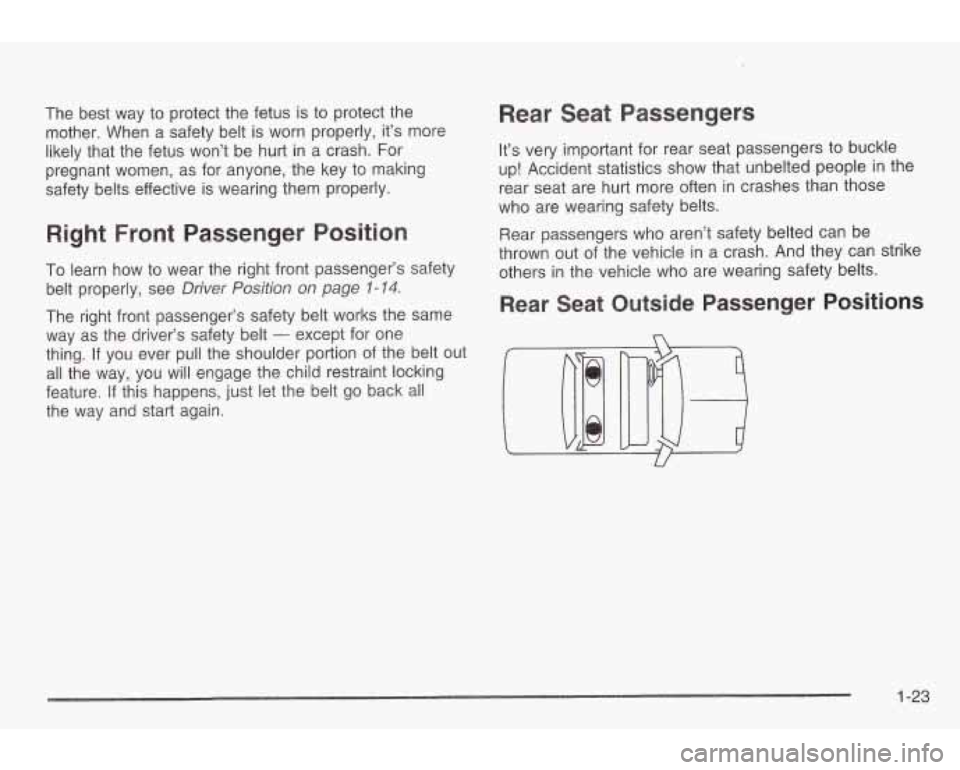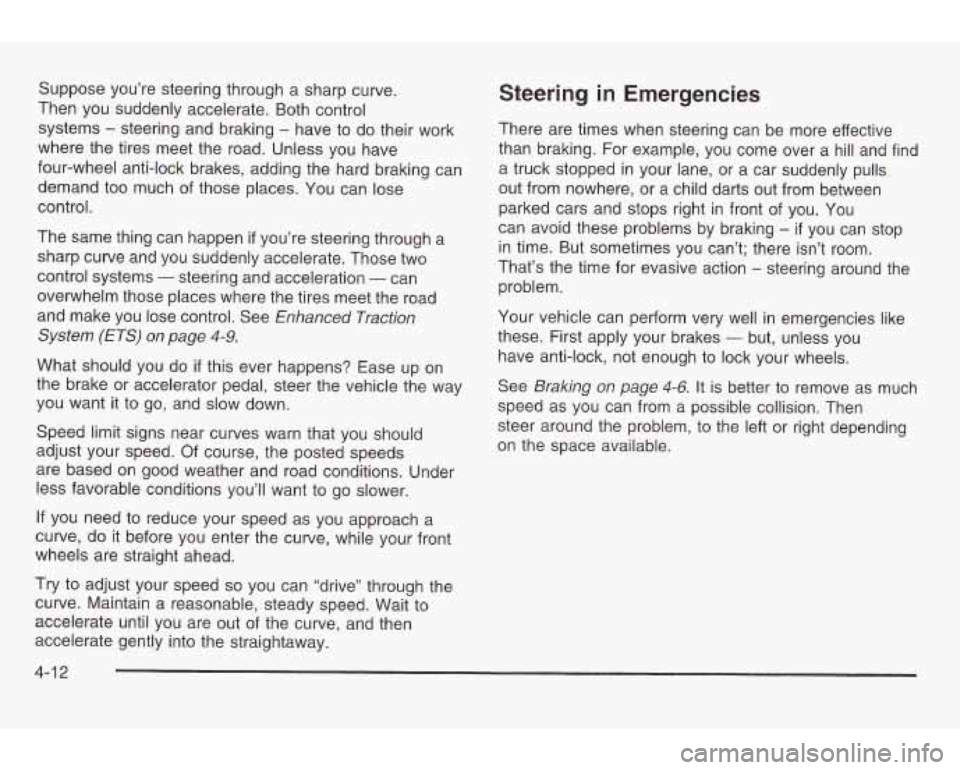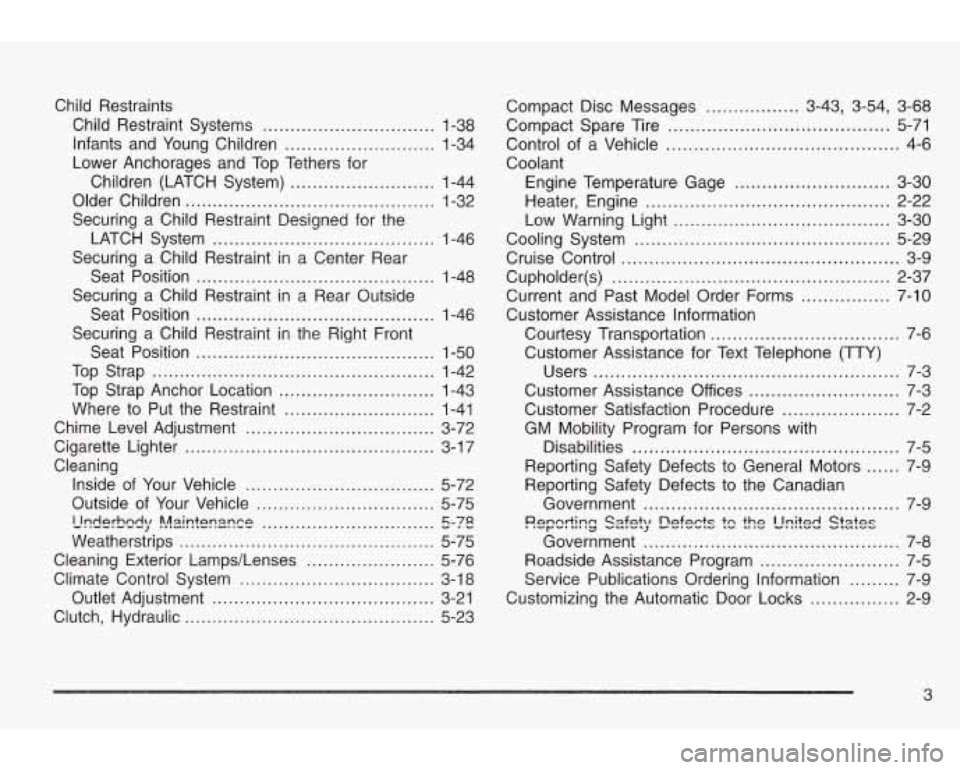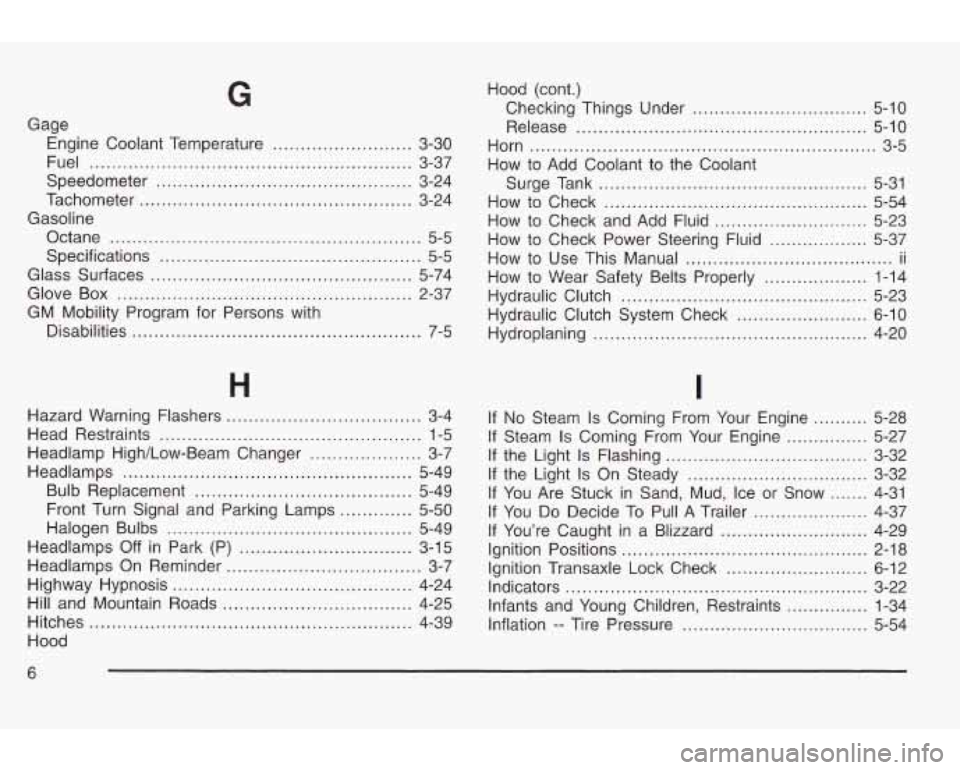child lock PONTIAC GRAND AM 2003 Owners Manual
[x] Cancel search | Manufacturer: PONTIAC, Model Year: 2003, Model line: GRAND AM, Model: PONTIAC GRAND AM 2003Pages: 354, PDF Size: 16.3 MB
Page 2 of 354

The 2003 Pontiac Grand Am Owner Manual
Seats and Restraint Systems ........................... 1-1
Front Seats ............................................... 1-2
Rear Seats ............................................... 1-8
Safety Belts .............................................. 1-9
Child Restraints ....................................... 1-32
Supplemental Restraint
System
(SRS) ...................................... 1-53
Restraint System Check ............................ 1-60
Keys ........................................................ 2-2
Doors and Locks ....................................... 2-7
Theft-Deterrent Systems ............................ 2-1 7
Starting and Operating Your Vehicle ........... 2-18
Mirrors .................................................... 2-35
Sunroof .................................................. 2-38
Instrument Panel Overview .......................... 3-2
Climate Controls ...................................... 3-1 8
\Warning Lights, Gages a.nd Indicators ......... 3-22
Audio System@) ....................................... 3-38
Features and Controls ..................................... 2-1
Windows ................................................. 2-1 5
Stcr3.g~ .A rean ~ ................... 2-37 ..........
Instrument Panel ............................................. 3-1
Driving Your Vehicle ....................................... 4-1
Your Driving, the Road, and Your Vehicle ..... 4-2
Towing ................................................... 4-32
Service ..................................................... 5-3
Fuel ......................................................... 5-5
Checking Things Under
Service
and Appearance
Care .......................... 5-1
the Hood ............................................. 5-10
Bulb Replacement .................................... 5-49
Windshield Wiper Blade Replacement ......... 5-52
Tires ...................................................... 5-53
Appearance Care ..................................... 5-72
Vehicle Identification ................................. 5-80
Electrical System ...................................... 5-81
Capacities and Specifications ..................... 5-86
Normai iviainienance Fiepiawl I 1t.1-1; F&iJiS ...... 5-00 nn
Maintenance Schedule ..................................... 6-1
bhintenance Schedule ................................ 6-2
Customer Assistance Information .................... 7-1
Customer Assistance Information .................. 7-2
Index ............................................................... ..I
Page 6 of 354

These are some examples of vehicle symbols you may find on your vehicle:
POSSIBLE A
CAUTION
INJURY
PROTECT EYES BY
SHIELDING
CAUSTIC
BATTERY
4CID COULD CAUSE
BURNS
AVOID
SPARKS
OR
FLAMES
SPARK
OR
FLAME 'lb'
COULD
EXPLODE
-
BATTERY
1
I
LATCH BOTH LAP AND
SHOULDER BELTS TO
PROTECT OCCUPANT
4
DO NOT TWIST SAFETY
BELT WHEN ATTACHING
FASTEN SEAT
BELTS
MOVE SEAT FULLY
\!&
REARWARD+ /z
SECURE
CHILD SEAT
PULL BELT
COMPLETELY
-HEN SECURE
CHILD SEAT
?"!"!E?
WINDOW DO
NOT INSTALL
A REAR-FACING
CHILD RESTRAINT IN THIS SEATING
POSITION
DO NOT INSTALL A
FORWARD-FACING CHILD RESTRAINT IN THIS SEATING POSITION
DOOR LOCK UNLOCK LIGHTING
-
PARKING PC
LAMPS
FOG n LAMPS w
ENGINE
COOLANT TEMP
CHARGING
1-1
BAlTERY SYSTEM
COOLANT
a
ENGINE OIL
PRESSURE
Wb
ANTI-LOCK fm)
BRAKES \u/
FJ
ACCESS
ENGINE
COOLANT FAN
FUEL
OWNER'S MANUAL
SERVICE
SERVICE
iviAi\iuWi
V
Page 21 of 354

Q: If I’m a good driver, and I never drive far from
home, why should
I wear safety belts?
A: You may be an excellent driver, but if you’re in an
accident
- even one that isn’t your fault - you and
your passengers can be hurt. Being
a good
driver doesn’t protect you from things beyond your
control, such as bad drivers.
Most accidents occur within 25 miles (40 km)
of home. And the greatest number of serious
injuries and deaths occur at speeds of less than
40 mph (65 km/h).
Safety belts are for everyone.
How to Wear Safety Belts Properly
This part is only for people of adult size.
Be aware that there are special things
to know about
safety belts and children. And there are different
rules for smaller children and babies.
If a child will be
riding in your vehicle, see
Older Children on page 1-32
or lnfants and Young Children on page 1-34. Follow
those rules for everyone’s protection. First,
you’ll want
to know which restraint systems your
vehicle has.
We’ll start with the driver position.
Driver Position
This part describes the driver’s restraint system.
Lap-Shsulder Belt
The driver has a lap-shoulder belt. Here’s how to wear it
properly.
1. Close and lock the door.
2. Adjust the seat so you can sit up straight. To see
how, see
Manual Seats on page 1-2 or Six-Way
Power Driver Seat on page 1-3.
1-14
Page 30 of 354

The best way to protect the fetus is to protect the
mother. When a safety belt is worn properly, it’s more
likely that the fetus won’t be hurt in a crash. For
pregnant women, as for anyone, the key
to making
safety belts effective is wearing them properly.
To learn how to wear the right front passenger’s safety
belt properly, see
Driver Position on page 1-14.
The right front passenger’s safety belt works the same
way as the driver’s safety belt
- except for one
thing.
If you ever pull the shoulder portion of the belt out
all the way, you will engage the child restraint locking
feature.
If this happens, just let the belt go back all
the way and start again.
Rear Seat Passengers
It’s very important for rear seat passengers to buckle
up! Accident statistics show that unbelted people in the
rear seat are hurt more often in crashes than those
who are wearing safety belts.
Rear passengers who aren’t safety belted can be
thrown out of the vehicle in a crash. And they can strike
others in the vehicle who are wearing safety belts.
Rear Seat Outside Passenger Positions
1-23
Page 58 of 354

3. Pick up the latch plate, and run the lap and shoulder
portions of the vehicte’s safety belt through or
around the restraint. The child restraint instructions
will show you how.
5. Pull the rest of the shoulder belt all the way out of
the retractor to set the lock.
4. Buckle the belt. Make sure the release button is
positioned so you would be able to unbuckle the
safety belt quickly
if you ever had to.
1-51
Page 76 of 354

Doors and Locks
Unlocked doors can be dangerous. Passengers
- especially children - can
easily open the doors and fall out of a
moving vehicle. When a door is locked, the
handle won’t open
it. You increase the
chance of being thrown out of the vehicle
in a crash
if the doors aren’t locked. So,
wear safety belts properly and lock the
doors whenever you drive.
Young children who get into unlocked
vehicles may be unable to get out.
A child
can be overcome by extreme heat and can
SIJffer permanent injuries or even death
from heat stroke. Always lock your vehicle
whenever you leave
it.
Outsiders can easily enter through an
unlocked door when you slow down or
stop your vehicle. Locking your doors can heip
prevent this from happening.
There are several ways to lock and unlock your vehicle.
From the outside, use your key or remote keyless
entry system,
if your vehicle is equipped with this
feature. If your vehicle
has remote keyless entry, you
can only use your key
to unlock the driver’s side door
2-7
Page 80 of 354

The rear doors on your vehicle cannot be opened from
the inside when this feature is in use. If you want to
open a rear door when the security lock is on, do
the following:
1. Unlock the door from the inside.
2, Then open the door from the outside.
If you don’t cancel the security lock feature, adults or
older children who ride in the rear won’t be able to open
the rear door from the inside. You should let adults
and older children know how these security locks work,
and how to cancel the locks.
To cancel
a rear door lock, do the following:
1. Unlock the door from the inside and open it from
2. Move the switch down.
3. Do the same to the other rear door.
the outside.
The rear doors will now work normally.
Lockout Protection
Lockout protection is a standard feature intended to
provide enhanced security and convenience. This
feature prevents a driver who has left the keys in the
ignition from locking the doors or using the power door
locks while any door
is open.
To override this feature, when the key
is in the ignition
and a door is open, hold the power door lock switch
for three seconds.
This feature cannot guarantee that you will never be
locked out of your vehicle. If you don’t leave the keys in
the ignition, or
if you use the manual door lock, or if
you use the remote keyless entry transmitter (if
equipped), you could still lock your keys inside your
vehicle. Always remember to take your keys with you.
Leaving Your Vehicle
If you are leaving your vehicle, open your door and
set the locks from the inside, then get out and close
&I. - ^I - - .. 11 le UUUl.
2-1 1
Page 191 of 354

Suppose you’re steering through a sharp curve.
Then you suddenly accelerate. Both control
systems
- steering and braking - have to do their work
where the tires meet the road. Unless you have
four-wheel anti-lock brakes, adding the hard braking can
demand
too much of those places. You can lose
control.
The same thing can happen
if you’re steering through a
sharp curve and you suddenly accelerate. Those two
control systems
- steering and acceleration - can
overwhelm those places where the tires meet the road
and make you lose control. See
Enhanced Traction
System
(ETS) on page 4-9.
What should you do if this ever happens? Ease up on
the brake or accelerator pedal, steer the vehicle the way
you want it
to go, and slow down.
Speed limit signs near curves warn that you should
adjust your speed. Of course, the posted speeds
are based on good weather and road conditions. Under
less favorable conditions you’ll want
to go slower.
If you need
to reduce your speed as you approach a
curve, do it before you enter the curve, while your front
wheels are straight ahead.
Try to adjust your speed so you can “drive” through the
curve. Maintain a reasonable, steady speed. Wait
to
accelerate until you are out of the curve, and then
accelerate gently into the straightaway.
4-1 2
Steering in Emergencies
There are times when steering can be more effective
than braking. For example, you come over a hill and find
a truck stopped in your lane, or
a car suddenly pulls
out from nowhere, or a child darts out from between
parked cars and stops right in front of you. You
can avoid these problems by braking
- if you can stop
in time. But sometimes you can’t; there isn’t room.
That’s the time for evasive action
- steering around the
problem.
Your vehicle can perform very well in emergencies like
these. First apply your brakes
- but, unless you
have anti-lock, not enough
to lock your wheels.
See
Braking on page 4-6. It is better to remove as much
speed as you can from a possible collision. Then
steer around the problem,
to the left or right depending
on the space available.
Page 342 of 354

Child Restraints
Child Restraint Systems
............................... 1-38
Infants and Young Children
........................... 1-34
Lower Anchorages and Top Tethers for
Children (LATCH System)
.......................... 1-44
Older Children
............................................. 1-32
Securing a Child Restraint Designed for the
LATCH System
........................................ 1-46
Securing a Child Restraint in a Center Rear
Seat Position
........................................... 1-48
Securing a Child Restraint in a Rear Outside
Seat Position
........................................... 1-46
Securing a Child Restraint in the Right Front
Seat Position
........................................... 1-50
Top Strap
................................................... 1-42
Top Strap Anchor Location
............................ 1-43
Where to Put the Restraint
........................... 1-41
Chime Level Adjustment
.................................. 3-72
Cigarette Lighter
............................................. 3-1 7
Cleaning Inside of Your Vehicle
.................................. 5-72
Outside
of Your Vehicle ................................ 5-75
Weatherstrips .............................................. 5-75
Cleaning Exterior Lamps/Lenses ....................... 5-76
Climate Control System
................................... 3-18
Outlet Adjustment
........................................ 3-21
Clutch, Hydraulic
............................................. 5-23
Yl?derhndy
M2l!?f5!?9!?ce ............................... E;-7g
Compact Disc Messages ................. 3.43. 3.54.
3-68
Compact Spare Tire
........................................ 5-71
Control of a Vehicle .......................................... 4-6
Coolant Engine Temperature Gage
............................ 3-30
Heater. Engine
............................................ 2-22
Low Warning Light ....................................... 3-30
Cooling System
.............................................. 5-29
Cruise Control
.................................................. 3-9
Current and Past Model Order Forms
................ 7-10
Customer Assistance Information Courtesy Transportation
.................................. 7-6
Customer Assistance for Text Telephone (TTY)
Users
....................................................... 7-3
Customer Assistance
Off ices ........................... 7-3
Customer Satisfaction Procedure
..................... 7-2
GM Mobility Program for Persons with
Disabilities
................................................ 7-5
Reporting Safety Defects to General Motors
...... 7-9
Reporting Safety Defects to the Canadian
Government
.............................................. 7-9
Government
.............................................. 7-8
Roadside Assistance Program
......................... 7-5
Service Publications Ordering Information
......... 7-9
Customizing the Automatic Door Locks
................ 2-9
Cupholder(s)
.................................................. 2-37
Fep5flt-1~ saf&/ nnfnptc to the IJn]fed sfzfe~ J --'VV.-
3
Page 345 of 354

G
Gage Engine Coolant Temperature
......................... 3-30
Fuel
.......................................................... 3-37
Speedometer
.............................................. 3-24
Tachometer
................................................. 3-24
Octane
........................................................ 5-5
Specifications ............................................... 5-5
Glass Surfaces ............................................... 5-74
Glove Box
..................................................... 2-37
GM Mobility Program for Persons with
Disabilities
.................................................... 7-5
Gasoline
H
Hazard
Warning Flashers .......................
Head Restraints ...................................
Headlamp High/Low-Beam Changer ........
Headlamps ..........................................
Bulb Replacement .............................
Halogen Bulbs ..................................
Headlamps Off in Park (P) .....................
Headlamps On Reminder .......................
Highway Hypnosis .................................
Hill and Mountain Roads ........................
Hitches ................................................
Hood Front
Turn Signal and Parking Lamps
...
........... 3-4
........... 1-5
........... 3-7
......... 5-49
......... 5-49
......... 5-50
......... 5-49
......... 3-15
........... 3-7
......... 4-24
......... 4-25
......... 4-39 Hood
(cont.)
Checking Things Under
................................ 5-10
Release ..................................................... 5-10
Horn
............................................................... 3-5
How to Add Coolant to the Coolant
Surge Tank
................................................. 5-31
How
to Check ................................................ 5-54
How to Check and Add Fluid
............................ 5-23
How to Check Power Steering Fluid
.................. 5-37
How
to Use This Manual ...................................... ii
How to Wear Safety Belts Properly ................... 1-14
Hydraulic Clutch
............................................. 5-23
Hydraulic Clutch System Check
........................ 6-10
Hydroplaning .................................................. 4-20
I
If No Steam Is Coming From Your Engine .......... 5-28
If Steam Is Coming From Your Engine ............... 5-27
If the Light Is Flashing ..................................... 3-32
If the Light Is On Steady ................................. 3-32
If You Are Stuck in Sand, Mud, Ice or Snow ....... 4-31
If You Do Decide To Pull A Trailer ..................... 4-37
If You’re Caught in a Blizzard ........................... 4-29
Ignition Positions
............................................. 2-18
Ignition Transaxle Lock Check
.......................... 6-12
Indicators
....................................................... 3-22
Inflation
-- Tire Pressure .................................. 5-54
Infants
and Young Children, Restraints
............... 1-34
6